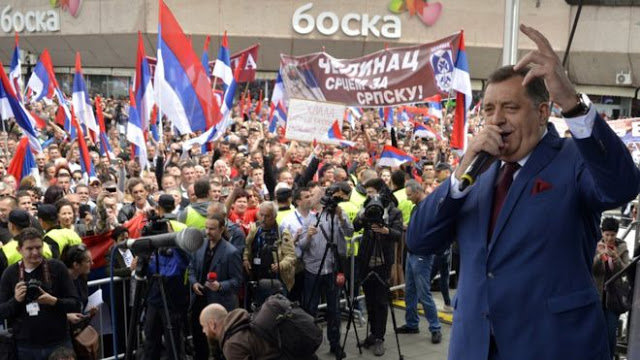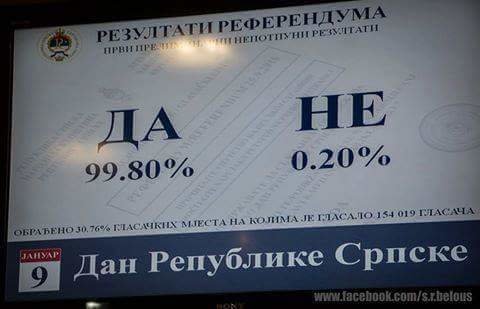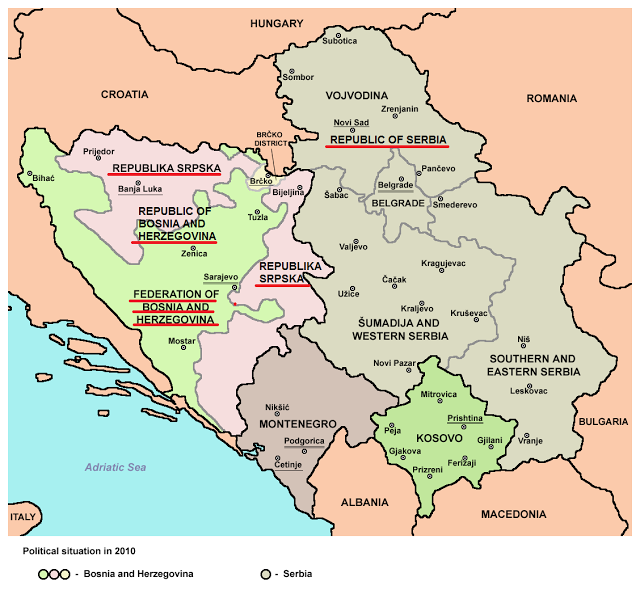
Republika Srpska - the Serbian autonomous state locked inside of Bosnia & Herzegovina - held a game-changing referendum yesterday. The referendum was nominally over the recognition of a state holiday - Independence Day. It was publicly endorsed and supported by the Prime Minister of Republika Srpska, Milorad Dodik.
Last night, the final votes were tallied up, with an overwhelming 99.8% voting 'Yes' and approving of recognition of Independence Day.
But critics and supporters, on both sides, unanimously agree that it is really a test run for a very likely referendum on an actual independence bid in the future, to break from the Republic of Bosnia & Herzegovina, and with the potential to join with the Republic of Serbia, and its capital of Belgrade, to its east. This is a move that Russia backs.
Such a referendum for independence can occur now at any time between the present, and the publicly discussed year of 2018. The precise dates will depend on the speed that NATO moves with Bosnian leaders to push the fragile, multi-confessional and multi-ethnic post-Yugoslav state into the NATO alliance and destabilizing constitutional reforms.
This referendum move comes against NATO's official warnings, and even threats of violence to possibly stop the referendum from the NATO-allied Bosniak-dominated capital of B&H, Sarajevo. These threats of violence did not go unnoticed by the government of the Republic of Serbia's seat in Belgrade, the independent UN-recognized state to the east of both the Federation of B&H and Republika Srpska.
The Republic of Serbia (not to be confused with Republika Srpska) is neither a part of the EU nor NATO. B&H, including the Republika Srpska, is not in NATO either, but the leadership in the capital of Sarajevo have moved quickly in recent years to join the Atlanticist alliance.
Serbian Prime Minister Vucic, reflecting diplomatic norms on matters relating to the internal machinations of other states, had expressed an initially neutral position of non-interference in the Bosnian referendum matter.
But following Sarajevo's threats of violence against the Serbian ethno-religious group in Republika Srpska, Serbia's Foreign Minister Ivica Dačić, after consultation with Russian Foreign Minister Sergei Lavrov, was forced to make a clearer statement that Serbia's security forces would "not stand by" if the referendum in neighboring Republika Srpska faced violence at the hands of Sarajevo's forces.
Such talk at the official level has been unheard of since the end of the Yugoslav civil war, which was fought from 1991 to 2001. Even western academics on the subject, including Noam Chomsky, have effectively demonstrated that the dismantling of Yugoslavia was a project spearheaded by the US and Germany, with Albania and Croatia being the primary beneficiaries in the region.
It is unlikely that the US and the RF will find points of agreement on this matter, given its parallels to other wars presently being fought between the two powers, and their unmoved positions on this matter. Combined with Russia's insistence on building a gas pipeline through the Balkans, and NATO's opposition to it, this greatly increases the chances of a new conflict in the Balkans.
What triggered the Referendum Movement
NATO has held several high-level meeting with B&H officials in Sarajevo apparently aimed at fast-tracking the latter's bid to enter NATO, going back to 2013.
This was synchronized with the organization of a social protest movement in 2014, ostensibly about labor rights and unemployment in Tuzla, the former industrial capital of Bosnia, which this author and our Russian colleague, Andrew Korybko, pointed out was likely an EU or NATO ruse. This is because a key component of the protesters' demands were changes to the constitution which in fact would undercut the present arrangement in which Republika Srpska maintains an important degree of autonomy. This includes an ethnic Serbian defense force operating with mirrored autonomy in the autonomous territory of Republika Srpska.
The actual border between Republika Srpska and the Republic of Serbia is rather porous, with the border control looking and acting more like a toll booth than a national border between two separate states.
A Bosniak-led social movement, couched to western liberal audiences as a secular center-left labor reform initiative, is in fact an Al Qaeda-sympathizing, Salafist-led jihad movement using the Qutbist protest politics of the Muslim Brotherhood. Their aim is to consolidate Sarajevo's control over the presently autonomous Republika Srpska, and this is inline with publicly expressed views from the EU and NATO on constitutional reform.
From the document "Reforming Bosnia & Herzegovina's Defenses", published by NATO's official public journal NATO Review, James R. Locher III and Michael Donley analyse the progress that Bosnia and Herzegovina has made in the field of defence reform.
They write:
NATO has dug into Bosnia (also referred to in this article as B&H) and isn't giving up its position. The reforms on security involve centralizing command and eliminating any autonomous security forces on the part of Republika Srpska, which is already under-powered as a result of forced agreements.Bosnia and Herzegovina has managed to meet nearly all of NATO's expectations. Following an intense period of consensus building and negotiation between May and September 2003, the Defence Reform Commission reached unanimous agreement on a 293-page report setting out the way forward. This report included draft changes to the two entity constitutions, three entity-level laws and two state-level laws, as well as proposals for two new laws, including a state-level defence law.
Other evidence that the situation in this region is not stable, is that the primary threat to the Republika Srpska's security forces as understood by these forces, is the Bosnian military itself.
Last February, the Russian Federation announced they would be training the Republika Srpska's security forces in a joint training project.
NATO and Gulf Monarchies have also prepared their own paramilitary forces in Bosnia, parallel to the military. These are primarily fighting in ISIS and Al-Nusra brigades, but the facilities to raise and recruit these fighters are inside of Bosnia.
The largest Al Qaeda/ISIS training camp west of Istanbul is located today in Bosnia. The largest indigenous European ethno-religious group to be involved in the Libyan and Syrian wars, are Bosniaks. Bosniaks were originally, primarily, Serbian children taken by Ottoman conquerors from their parents to join the Janissary Army and adopt the religion of Islam. The language spoken by Bosniaks today is still Serbian. They remain, generally speaking, phenotypically indistinguishable from Serbians - the main differences between the two people being primarily religious and historical.
But the historical ties between Bosnian Muslims and powers like Turkey continue to this day. Western media reported the Tuzla protest movement while excluding mention of Saudi and Turkish-backed groups involved in the main organizing. Organizing work on the ground was done primarily by the largest 'moderate' Islamist party in Bosnia, the SDA.
Significant funding from Gulf Monarchies and the EU's Jean-Claude Juncker's European People's Party, of which they are a member org, goes to the Party for Democratic Action, or SDA, the 'right-wing' social conservative (Sharia), pro-EU and Islamist political party, and the largest Bosniak party of Bosnia.
In this sense, the intersection of pro-NATO, pro-EU and Islamist religious movements posing as progressive center-left, can be said to mirror the political-media strategy used in Libya with the TNC, with the Syrian Democratic Transitional Council and the FSA.
As a result of clear warnings from Sarajevo that it would make moves to abolish the autonomous status of Republika Srpska, Russian Foreign Minister Lavrov made a very clear statement in 2014 that in the event that Sarajevo were to change the constitution, that Russia would be in the position of "recognizing the right to self-determination of the two state-forming peoples" who comprise the three people state of the Republic of B&H - referring obviously to the historic precedent of Croats and Serbs - though in such case the particular focus on Serbians was the intention of his remarks, as Serbs in Bosnia have openly discussed secession in the event of a constitutional crisis.
Taken all together, this gives the entire context of yesterday's 'Test Run' referendum on independence in Republika Srpska.
Background
The modern Republic of B&H's present structure is the product of two primary points of history - the structure of the Socialist Federal Republic of Yugoslavia, and the Dayton Accords. The Dayton Accords were negotiated and agreed to in 1995 during the Yugoslav civil war, four years before the NATO bombing of Serbia and its capital, Belgrade. The institutions and political reality created by the Dayton Accords are by and large the focus of the present contest.
The modern Republic of B&H is comprised of the Republika Srpska, and the Federation of Bosnia and Herzegovina. The latter was previously called the Bosniak-Croat Federation, because it is itself made up of these two primary religious groups.
As this author wrote previously, the coming period and precisely such a crisis would represent the opportunity for the 'two Serbias' to rejoin:
Serbia is in a delicate position where it has the possibility of either gaining Republika Srpska and regaining Kosovo, while maintaining regions like Vojvodina, or by fracturing and shattering further, as part of a precursor to an actual conflict between devolving local powers and hostile regional states.Fort Russ editor and translator, and Special Projects Director for the Center for Syncretic Studies, Jafe Arnold, wrote an expansive and prescient piece on the subject for GIA earlier in the year. In this, he warns:
In recent months, increasing tension in the relationship between the two political entities comprising the state of Bosnia and Herzegovina, the Bosnia-Herzegovina Federation and Republika Srpska, has threatened to boil over the kettle that is the uneasy geopolitical arrangement in the space of former Yugoslavia.As events have continued to escalate, and the NATO/Islamist axis has been exposed, the situation now in the countries of the former Yugoslavia is less stable than at any point since 2001.
Serbian NGO's work to educate and bring stability
The Center for Syncretic Studies was established in Belgrade in 2013 in part as a specific response to the growing specter of a renewed major conflict in the region. As a non-profit educational organization, it has worked to disseminate publicly available information for both Anglophonic and Serbian audiences, to understand the significance of the west Balkans, and Serbia in particular, in the present global crisis. The CSS has been following and forecasting events on this subject since its founding.
Fort Russ News has several editors who are also researchers and directors for the CSS. The CSS works in part on questions involving destabilization efforts on the part of NATO interests in this region, and the sorts of political mobilizations and ideological tools which can be developed to counter these. The CSS has worked with the Syrian consulate and Serbian political leaders to be better prepared for events which a number of analysts conclude are inevitable.
Events in Syria and Ukraine seem to generally confirm several of the CSS operating theses, regarding syncretic ideology, the color-spring tactic, in the context of 4GW, and new-media warfare, which may prove useful in working on similar questions as they arise in the coming months and years in the former Yugoslavia.






all of this war back to 2000 is to divest Russia from its economic connection to Europe? To butter up the Saudi because they are the smallest population by ceding the Med waterfront of Syria to them for their pipeline? Holy cow!